Are both aperture and shutter priority obsolete?
Dec 23, 2017 06:15:41 #
A year ago, I was looking for a reason to use aperture-priority, so I could promote its use for those situations where it really is the best choice to accomplish the task. The other choices I had all seemed to work far better for every nature subject I photograph that includes wildlife, close-ups, and landscapes. The big problems with aperture-priority are that it is an auto exposure mode and that often doesn’t work well when the size of a non-neutral subject varies considerably from shot to shot, or the ambient light levels drop, and the shutter slows down too much. Even worse is when the background reflectance changes quickly, such as blue sky to white clouds, or blue sky and dark gray mountains. I have always been a much bigger fan of shutter-priority in situations when ambient light changes rapidly, but backgrounds or subjects don’t mess it up. That also fell away with the introduction of Canon’s latest cameras like the 7D Mark II, 5D Mark IV, and 1DX Mark II, and perhaps others I have not tested. So now I struggle to find a reason for either one. Perhaps this is as it should be as both aperture and shutter priority answered a need in the film era when once a film was loaded into the camera, the ISO speed was locked unless you changed the film or push the entire roll.
The big change with digital is the ISO is every bit as variable as the shutter speed and f/stop. True the higher the ISO, the more noise might appear in the image, but new cameras are so much better with high ISOs and software helps us manage it too. Since August, I have shot at least 100,000 new nature images on four continents – North America, South America, Africa, and Europe – and not once have I opted for shutter or aperture priority. Whenever possible, I chose Manual exposure as I find that is the easiest and most full-proof exposure mode in situations where the ambient light isn’t changing much or quickly. In those cases where ambient light changes quickly, then the auto mode I favor, and nearly all the photographers I have met at both Bosque del Apache and Lake Coeur d’ Alene are using is Manual aperture and shutter speed, but Auto ISO with exposure compensation. Although Canon is new to this mode, the latest Canon cameras offer this Manual A & S, with Auto ISO and EC. I use it a lot, especially in Kenya where in a vehicle it is easy to drive from bright sun to shade in the forest and you must react instantly. Better to let the camera change the ISO to maintain the aperture and shutter speed than fiddle around with settings and miss the shot altogether.
In talking with many photographers at some of the wildlife hot spots in the US, it’s clear that many are moving this way. While it is true that aperture and shutter priority can get you there if everything is done right, and you have time to fiddle with dials, the skilled photographers I shoot with have all moved on to new ways of doing things. If you are a big fan of aperture and/or shutter priority, it would be in your best interest to consider the alternatives.
Look at the article posted on my web site at: https://www.gerlachnaturephoto.com/article-advanced-wildlife-exposure
This one is good for all systems, but especially Canon, as it reveals an efficient way to use manual aperture and shutter speed, Auto ISO, and exposure compensation by assigning the EC function to the SET button.
Another article I wrote for the Canon Learning Center is available too. It describes many of the problems with the commonly used auto exposure modes. http://www.learn.usa.canon.com/resources/articles/2017/gerlach-lenses-for-wildlife-photography.shtml?categoryId=12
By the way, The Canon Learning Center is loaded with instructional articles about many topics from leading shooters that are free to read. Everyone, and especially Canon photographers, should know about this excellent place for information. And finally, enjoy the upcoming holidays.
The big change with digital is the ISO is every bit as variable as the shutter speed and f/stop. True the higher the ISO, the more noise might appear in the image, but new cameras are so much better with high ISOs and software helps us manage it too. Since August, I have shot at least 100,000 new nature images on four continents – North America, South America, Africa, and Europe – and not once have I opted for shutter or aperture priority. Whenever possible, I chose Manual exposure as I find that is the easiest and most full-proof exposure mode in situations where the ambient light isn’t changing much or quickly. In those cases where ambient light changes quickly, then the auto mode I favor, and nearly all the photographers I have met at both Bosque del Apache and Lake Coeur d’ Alene are using is Manual aperture and shutter speed, but Auto ISO with exposure compensation. Although Canon is new to this mode, the latest Canon cameras offer this Manual A & S, with Auto ISO and EC. I use it a lot, especially in Kenya where in a vehicle it is easy to drive from bright sun to shade in the forest and you must react instantly. Better to let the camera change the ISO to maintain the aperture and shutter speed than fiddle around with settings and miss the shot altogether.
In talking with many photographers at some of the wildlife hot spots in the US, it’s clear that many are moving this way. While it is true that aperture and shutter priority can get you there if everything is done right, and you have time to fiddle with dials, the skilled photographers I shoot with have all moved on to new ways of doing things. If you are a big fan of aperture and/or shutter priority, it would be in your best interest to consider the alternatives.
Look at the article posted on my web site at: https://www.gerlachnaturephoto.com/article-advanced-wildlife-exposure
This one is good for all systems, but especially Canon, as it reveals an efficient way to use manual aperture and shutter speed, Auto ISO, and exposure compensation by assigning the EC function to the SET button.
Another article I wrote for the Canon Learning Center is available too. It describes many of the problems with the commonly used auto exposure modes. http://www.learn.usa.canon.com/resources/articles/2017/gerlach-lenses-for-wildlife-photography.shtml?categoryId=12
By the way, The Canon Learning Center is loaded with instructional articles about many topics from leading shooters that are free to read. Everyone, and especially Canon photographers, should know about this excellent place for information. And finally, enjoy the upcoming holidays.
Snow geese
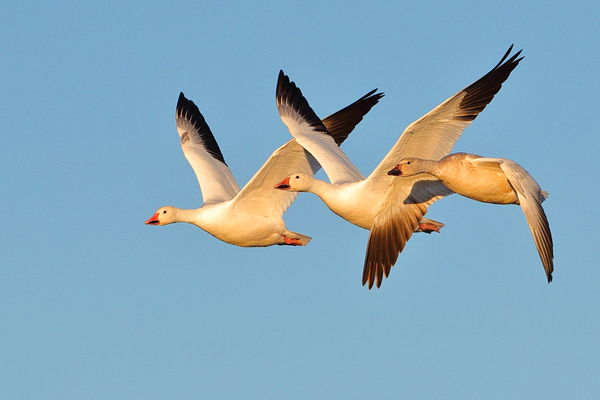
(Download)
The more typical snow goose leading the "blue morph" snow geese - adult and young of the year
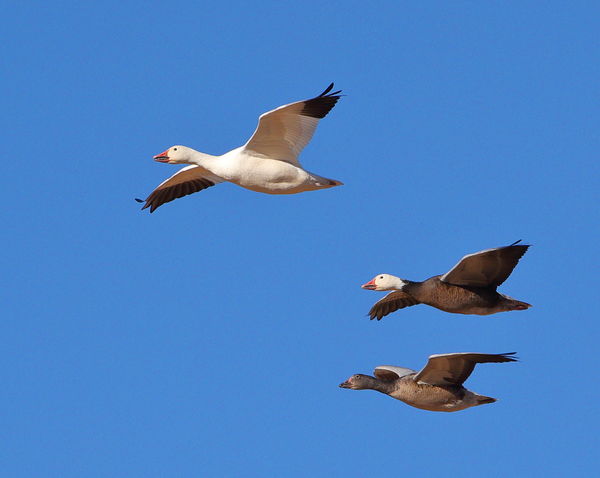
(Download)
Sandhill Crane
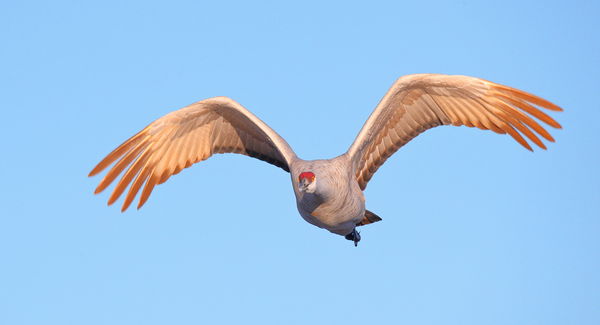
Snow and Ross's geese
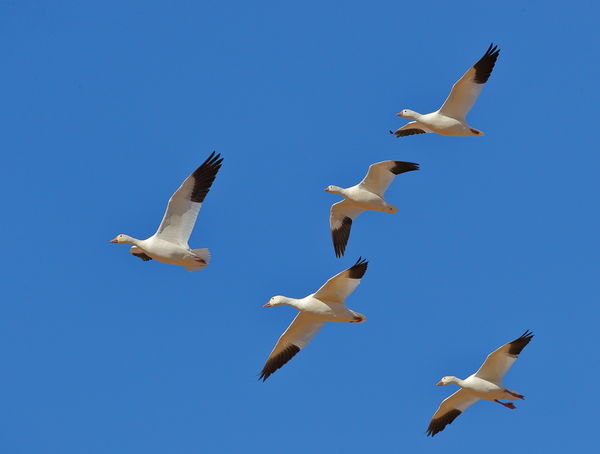
(Download)
Sandhill Cranes
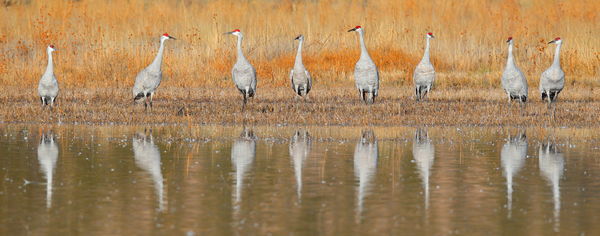
(Download)
Northern pintail
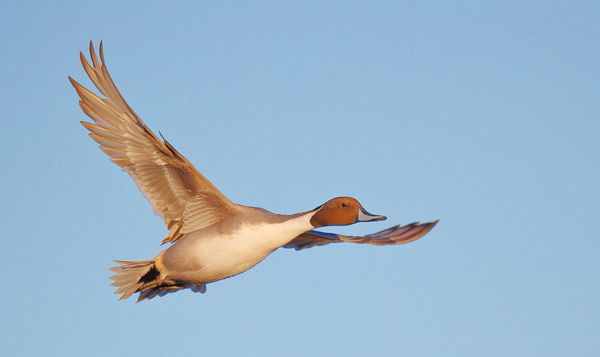
(Download)
Snow goose
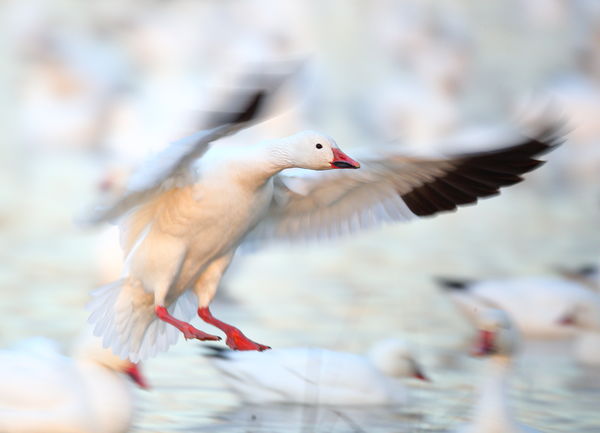
(Download)
Snow goose
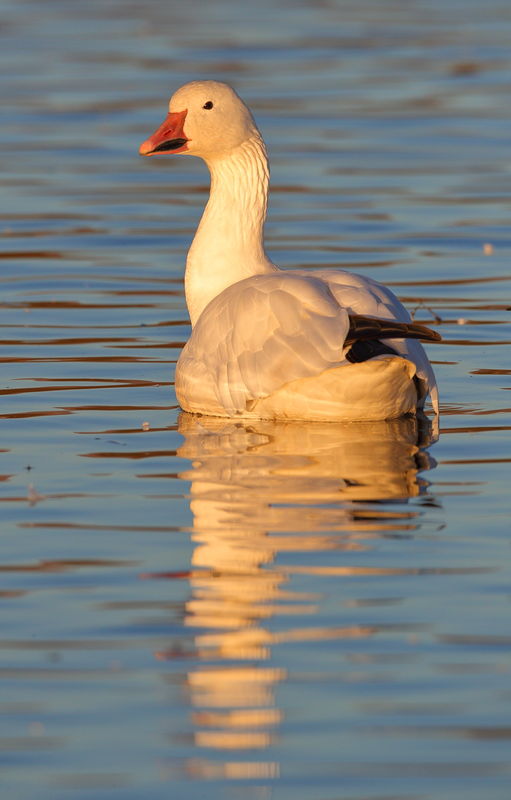
(Download)
Blue morph Snow Goose - when I was a biology students decades ago, we just called this a blue goose
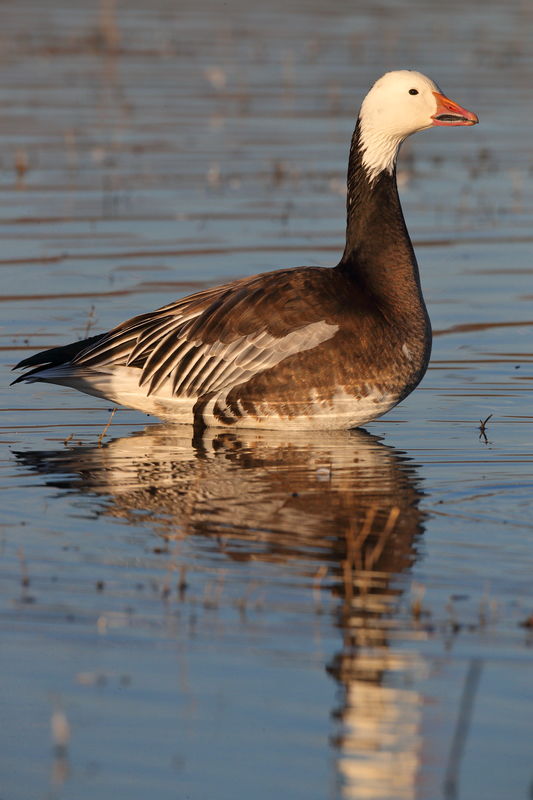
(Download)
Sandhill crane
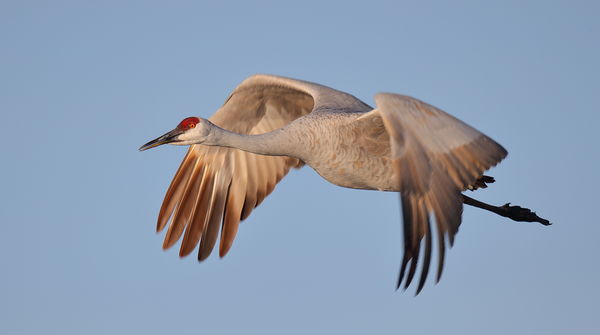
(Download)
Dec 23, 2017 06:31:47 #
Dec 23, 2017 06:34:56 #
John Gerlach wrote:
A year ago, I was looking for a reason to use aper... (show quote)
Good thoughts.
And yes I use the Canon Learning Center.
Dec 23, 2017 06:49:43 #
When I am not using full manual, I use auto ISO with a -.3 exposure adjustment as a default. Never use the program or shutter priority. With the clean files at high ISO, this works well. You need to be a little careful with back lit subjects, but this can be helped by using the spot meter setting rather than matrix metering.
Dec 23, 2017 06:56:25 #
Architect1776 wrote:
Good thoughts.
And yes I use the Canon Learning Center.
And yes I use the Canon Learning Center.
Very good. I find too many Canon shooters that don't know about it, so I am just trying to "get the word out."
Dec 23, 2017 06:57:26 #
I shoot 90% of my images in A Priority. I set ISO to a fixed value, depending on the situation. The main reason is to control DOF, it's almost manual with the camera setting the shutter speed only. It works for me, but whatever works for you is the way you should shoot.
Dec 23, 2017 07:18:02 #
John Gerlach wrote:
Very good. I find too many Canon shooters that don't know about it, so I am just trying to "get the word out."
I agree.
I tell friends about it when they ask a lot of questions as it is a good reference and can be returned to as needed or desired.
Dec 23, 2017 07:41:14 #
jimq wrote:
I shoot 90% of my images in A Priority. I set ISO to a fixed value, depending on the situation. The main reason is to control DOF, it's almost manual with the camera setting the shutter speed only. It works for me, but whatever works for you is the way you should shoot.
You will help yourself if you consider other methods. How does manual exposure, or manual A & S with auto ISO not control DOF? Aperture-priority is not a manual mode, it is autoexposure, just like ISO auto or shutter-priority. And on a Kenya safari, aperture-priority will cost you key images because you are in a vehicle that moves from the sun through shady forests and then back in the sun. If you are set for a sun exposure, and while momentarily in the shade and a leopard is walking along the other side of the creek, and will soon enter dense brush, you have no time to make adjustments to keep the shutter speed up. This happened to me last September. Using manual A & S, auto ISO, and EC took care of the light change instantly and I got the shot. Those who rely on aperture or shutter priority failed. Aperture priority lets the shutter slow too much, and shutter priority underexposes the leopard because the lens could not open up enough. Just trying to help!
Dec 23, 2017 08:09:38 #
Went full manual after 3mo into my photography journey which began 4yrs ago. Got tired very quickly of fighting the camera on the image that was in my mind. Use AUTO ISO sparingly for consistent DR, run and gun bit otherwise full manual all the time. With my buttons programmed the way I like, I can adjust the exposure triangle in sub-sec and get within 1-1.5 stops and fix it in post with minimal noise.
I do like Auto ISO for certain situations where lighting changes rapidly and it works well going from low to high light where the frame has consistent light. (Swinging from shooting something in the woods and then to the field).
Less success shooting a bird in a tree at level to sky overhead.
Will try using Auto ISO and EC and see what happens. Getting pretty comfy shooting at high speed on full manual but still open to new ideas)
I do like Auto ISO for certain situations where lighting changes rapidly and it works well going from low to high light where the frame has consistent light. (Swinging from shooting something in the woods and then to the field).
Less success shooting a bird in a tree at level to sky overhead.
Will try using Auto ISO and EC and see what happens. Getting pretty comfy shooting at high speed on full manual but still open to new ideas)
Dec 23, 2017 09:07:18 #
crazydaddio wrote:
Went full manual after 3mo into my photography jou... (show quote)
I totally agree with you. I greatly prefer full manual whenever it works best and this is most of the time for me. But, in situations where ambient changes a lot and rapidly, then the Auto ISO with manual A & S comes to my rescue. Seldom do I need auto at all for landscapes and macro, but wildlife can be a different matter entirely, especially when shooting in a vehicle where you may drive from dim to bright light in moments, such as on safari in Kenya or the cloud cover changes rapidly. And there are always exceptions. One comes to mind when leading my photo workshops on a cruise boat to photograph Pictured Rocks National Lakeshore. The boat goes along the shoreline and the rocks are in the golden afternoon sunshine, but then the boat turns the corner and the rock patterns are in full shade, Manual A & m with auto ISO worked well in that somewhat odd landscape photo opportunity.
Dec 23, 2017 09:29:18 #
John, thanks for a well-written piece.
I shoot Canon (7D, 6D & 5DIV). 90% of my shooting is in Manual Mode (M) (without or with flash set to HSS High-Speed Sync) where I set the Shutter speed/Aperture/Flash (or not), and I also use Auto ISO to accommodate what I am shooting, Sports, Scenes, Portraits etc. to suit my desired (sometimes) objectives. Yes, I do sacrifice to the demons of noise from time to time. However, I usually do get the shot and with a quick wash and rinse through a “De-Noise” program the image is usually acceptable to 11 X 14” and sometimes larger.
However, I am a fan of Aperture (AV) priority for fill flash (-1/3 to -5.0F) outdoors to lessen shadows on peoples faces and especially if they are back-lit. I also like to control the light in both M (Manual Mode) and AV (Aperture Priority) by using the Canon +/- compensation control wheel for flash and background exposure. I have also taken flash pics outside of flowers in fairly bright sunlight and by using the exposure compensation control wheel you can make the background go to black while the subject remains perfectly lit.
Note: This technique is also possible to do this with a Nikon. On YouTube, Brian Peterson demonstrates this technique using a Nikon. His demo also seemed a little more labor-intensive than what I use with Canon. No insult intended to my Nikon Brethren.
I do use TV (Shutter Speed) occasionally, but only for extremes in lighting or motion.
Bottom line, M, AV & TV (Canon-speak) all work for me depending on the circumstances.
And lastly to all of my fellow Ugly Hedge Hoggers, please have a Merry Christmas and a Happy, Healthy and Prosperous New Year and Keep on Shooting!
I shoot Canon (7D, 6D & 5DIV). 90% of my shooting is in Manual Mode (M) (without or with flash set to HSS High-Speed Sync) where I set the Shutter speed/Aperture/Flash (or not), and I also use Auto ISO to accommodate what I am shooting, Sports, Scenes, Portraits etc. to suit my desired (sometimes) objectives. Yes, I do sacrifice to the demons of noise from time to time. However, I usually do get the shot and with a quick wash and rinse through a “De-Noise” program the image is usually acceptable to 11 X 14” and sometimes larger.
However, I am a fan of Aperture (AV) priority for fill flash (-1/3 to -5.0F) outdoors to lessen shadows on peoples faces and especially if they are back-lit. I also like to control the light in both M (Manual Mode) and AV (Aperture Priority) by using the Canon +/- compensation control wheel for flash and background exposure. I have also taken flash pics outside of flowers in fairly bright sunlight and by using the exposure compensation control wheel you can make the background go to black while the subject remains perfectly lit.
Note: This technique is also possible to do this with a Nikon. On YouTube, Brian Peterson demonstrates this technique using a Nikon. His demo also seemed a little more labor-intensive than what I use with Canon. No insult intended to my Nikon Brethren.
I do use TV (Shutter Speed) occasionally, but only for extremes in lighting or motion.
Bottom line, M, AV & TV (Canon-speak) all work for me depending on the circumstances.
And lastly to all of my fellow Ugly Hedge Hoggers, please have a Merry Christmas and a Happy, Healthy and Prosperous New Year and Keep on Shooting!
John Gerlach wrote:
A year ago, I was looking for a reason to use aper... (show quote)
Dec 23, 2017 09:50:27 #
Dec 23, 2017 09:57:27 #
John Gerlach wrote:
A year ago, I was looking for a reason to use aper... (show quote)
Beautiful set John. The composition in the BIFs is excellent.
Dec 23, 2017 13:53:24 #
jimq wrote:
I shoot 90% of my images in A Priority. I set ISO to a fixed value, depending on the situation. The main reason is to control DOF, it's almost manual with the camera setting the shutter speed only. It works for me, but whatever works for you is the way you should shoot.
I generally use A priority with Auto ISO as well. I set an initial ISO value with an upper ISO boundary. I can also set a minimum shutter speed. With this combination, I am able to apply exposure compensation.
Dec 23, 2017 14:56:24 #
I pretty well default to manual aperture and shutter and auto ISO since my camera performs pretty well up to fairly high ISOs. Unfortunately, my particular body doesn’t support auto ISO and EC simultaneously, so for those occasional snow scenes and similar, I go back to full manual. Also, I use full manual with ETTL flash since auto ISO plus ETTL on my body defaults to ISO 400. I used to use shutter and aperture priority, but not anymore - auto ISO combines the control I want with the advantage of auto control for rapidly changing light.
If you want to reply, then register here. Registration is free and your account is created instantly, so you can post right away.







